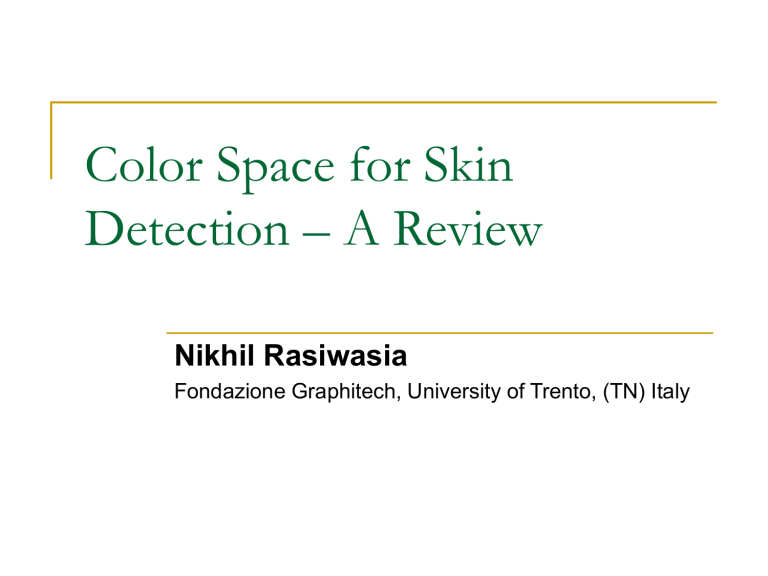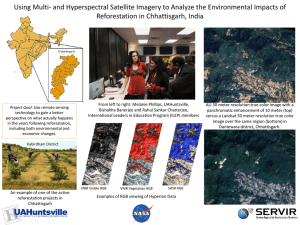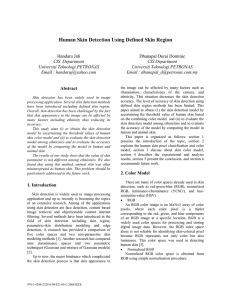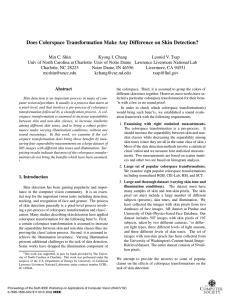Color Space for Skin Detection – A Review

Color Space for Skin
Detection – A Review
Nikhil Rasiwasia
Fondazione Graphitech, University of Trento, (TN) Italy
Contents
Papers under consideration
Why to detect skin?
Methods of Skin Detection
Using Skin Color
Advantages
Issues with Color
How exactly is the skin color modeled
Different Color Models
Comparison of different Color Models
Results from [1]
Results from [2]
Another perspective – Results from [3]
Conclusions
Papers under consideration
[1 ]Michael J Jones & James R Rehg, “Statistical Color
Models with Application to Skin Detection”
[2]D.Zarit, “Comparison of five color models in skin pixel classification”
[3]Albiol, “optimum color spaces for skin detection”
Other papers
[4]Min C. Shin “Does colorspace transformation make any difference on skin detection”
[5]Vezhnevets, “A survey on Pixel-Based skin color detection techniques”
Why to detect skin?
Person Detection
Face Detection and Face Tracking
Hand Tracking for
Gesture Recognition
Robotic Control
Other Human Computer Interaction
A filter for pornographic content on the internet
Other uses in video applications
Methods of Skin Detection
Pixel-Based Methods
Classify each pixel as skin or non-skin individually, independently from its neighbors.
Color Based Methods fall in this category
Region Based Methods
Try to take the spatial arrangement of skin pixels into account during the detection stage to enhance the methods performance.
Additional knowledge in terms of texture etc are required
Skin Color based methods - Advantages
Allows fast processing
Robust to geometric variations of the skin patterns
Robust under partial occlusion
Robust to resolution changes
Eliminate the need of cumbersome tracking devices or artificially places color cues
Experience suggests that human skin has a characteristic color, which is easily recognized by humans.
Issues with skin color
Are Skin and Non-skin colors seperable?
Illumination changes over time.
Skin tones vary dramatically within and across individuals.
Different cameras have different output for the identical image.
Movement of objects cause blurring of colours.
Ambient light, shadows change the apparent colour of the image.
What colour space to be used?
How exactly the colour distribution has to be modelled?
Different Color Models - Issues 2
Increased separability between skin and non skin classes
Decreased separability among skin tones
Cost of conversion for real time applications
What is the color distribution model used
Keeping the Illumination component – 2D color space vs. 3D color space
Stability of color space (at extreme values)
How exactly the colour distribution has to be modelled?
Non parametric – Estimate skin color distribution from the training data without deriving an explicit model of the skin.
Look up table or Histogram Model
Bayes Classifier
Parametric – Deriving a parametric model from the training set
Gaussian Model
What colour space to be used?
Different Color Models
RGB
Normalized RGB
HIS, HSV, HSL
Fleck HSV
TSL
YcrCb
Perceptually uniform colors
CIELAB, CIELUV
Others
YES, YUV, YIQ, CIE-xyz
RGB – Red, Green, Blue
Most common color space used to represent images.
Was developed with CRT as an additive color space
[1] – Rehg and Jones have used this color space to study the separability of the color space
Normalized RGB – rg space
2D color space as ‘b’ component is redundant
b = 1 – g – r
Invariant to changes of surface orientation relatively to the light source
HSV, HSI, HSL (hue, saturation, value/intensity/luminance)
High cost of conversion
Based on intuitive values
Invariant to highlight at white light sources
Pixel with large and small intensities are discarded as HS becomes unstable.
Can be 2D by removing the illumination component
Y Cr Cb
YCrCb is an encoded nonlinear RGB signal, commonly used by European television studios and for image compression work.
Y – Luminance component, C – Chorminance
Perceptually uniform colors
“skin color” is not a physical property of an object, rather a perceptual phenomenon and therefore a subjective human concept.
Color representation similar to the color sensitivity of human vision system should
Complex transformation functions from and to
RGB space, demanding far more computation than most other colorspaces
Results from [1] – Rehg & Jones
Used 18,696 images to build a general color model.
Density is concentrated around the gray line and is more sharply peaked at white than black.
Most colors fall on or near the gray line.
Black and white are by far the most frequent colors, with white occurring slightly more frequently.
There is a marked skew in the distribution toward the red corner of the color cube.
77% of the possible 24 bit RGB colors are never encountered (i.e. the histogram is mostly empty).
52% of web images have people in them.
General Color model - RGB
Marginal Distributions
Skin model
Non Skin Model
Other Conclusions
Histogram size 32 gave the best performance, superior to the size 256 model at the larger false detection rates and slightly better than the size 16 model in two places.
Histogram model gives slightly better performance as compared to Gaussian mixture.
It is possible that color spaces other than
RGB could result in improved detection performance.
Results from [2] Zarit et al.
They compared 5 different color spaces CIELab,
HSV, HS,Normalized RGB and YCrCb
Four different metrics are used to evaluate the results of the skin detection algorithms.
C % – Skin and Non Skin pixels identified correctly
S % – Skin pixels identified correctly
SE – Skin error – skin pixels identified as non skin
NSE – Non Skin error – non skin pixels identified as skin
They compared the 5 color space with 2 color models – look up table and Bayes classifier
Look up table results
HSV, HS gave the best results
Normalized rg is not far behind
CIELAB and
YCrCb gave poor results
Bayes method results
Using different color space provided very little variation in the results
Another perspective – [3] Albiol et al,
“optimum color spaces for skin detection”
As from [2] we see that using different methods (Look up table and Bayes) the results were different
Abstract: The objective of this paper is to show that for every color space there exists an optimum skin detector scheme such that the performance of all these skin detectors schemes is the same. To that end, a theoretical proof is provided and experiments are presented which show that the separability of the skin and no skin classes is independent of the color space chosen.
Features
Used 4 color space – RGB, YCrCb, HSV, Cr Cb
Proved mathematically for the existence of optimum skin color detector D(x p
)=> highest detection rate
(P
D for a given false alarm rate P
Pearson Test
FA
) using Neyman-
Results
CbCr color space It can be noticed that the performance is lower since the transformation from any three dimensional color space to the bidimensional CbCr color is non invertible if an optimum skin detector is designed for every color space, then their performace will be the same.
Conclusions
The skin colors form a separate cluster in the RGB color space.
Hence skin color can be used as a cue for skin detection in images and videos.
The performance of different color space may be dependent on the method used to model the color for skin pixel.
For the common methods – Look up table, bayes classifier, gaussian the results are
Look up table – HS performs the best followed by normalized
RGB
Bayes – is not largely affected by the the color space
Gaussian – No general result can be derived from the papers under consideration
Removing the illumination component does increase the overlap between skin and non skin pixels but a generalization of training data is obtained
Results from [5]
Colorspace does not matter in nonparametric (Bayes) methods, though the overlap is a significant performance metric in the parametric (Gaussian) case.
Dropping of luminance seems logical. – Though the skip overlap increases due to the dimensionality reduction, but there is a generalization of the training data.
Prefers normalized RG, HS colorspace.
Just by assessing skin overlap can not give an idea of the goodness of the colorspace as different modelling methods react very differently on the colorspace change.










